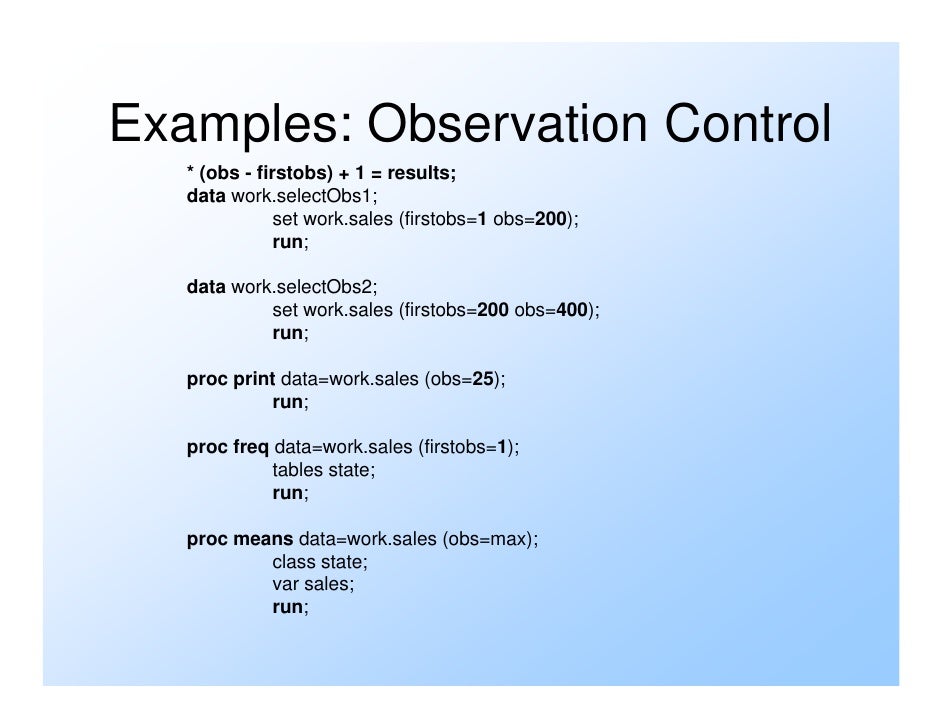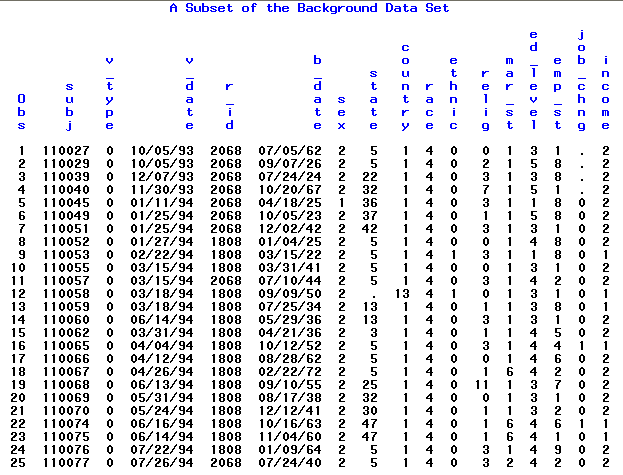
The FIRSTOBS= data set option overrides the FIRSTOBS= system option for the individual data set. While the FIRSTOBS= data set option specifies a starting point for processing, the OBS= data set option specifies an ending point. The two options are often used together to define a range of observations to be processed. When the FIRSTOBS= data set option specifies a starting point for processing, the OBS= data set option specifies an ending point.
Using the FIRSTOBS= system option determines the first observation that is read for all steps for the duration of your current SAS session or until you change the setting. To affect any single file, you can use the FIRSTOBS= data set option.
Il choisira si besoin de. Import de données : création d’une table SAS à partir d’un fichier texte Obs Pays Gini Farm Rent Gnpr Labo Inst Ecks Deat Demo Australie 92. If the FIRSTOBS= option has not been specifie the default is 1. I have been using firstobs in the set.
Recently I saw a code. By default, FIRSTOBS=1. You can use FIRSTOBS= and OBS= together to define a range of observations for SAS to process. RE: Firstobs option with Proc Sql?

The first example uses data from the Sashelp. Heart data set, which contains data for 2patients in a medical study of heart disease. The data are distributed with SAS. Je suis un nouvel utilisateur de SAS Unix 9. Lors de l’importation d’un fichier Excel sous SAS au moyen de la procédure PROC IMPORT, la première ligne indique à SAS quel nom donné aux variables au lieu d’utiliser les lettres de l’alphabet.
L’option par défaut est GETNAME=YES. Dans un cas, des informations peuvent être perdues. C’est ce que je vous propose de voir ici. SAS Training Course In Mumbai TryCatch Classes.
The SORT Procedure Beyond the Basics. For example, if you are reading a comma separated file or a tab separated file that has the variable names on the first line, then use firstobs=to tell SAS to begin reading at the second line (so it will ignore the first line with the names of the variables). You need to precede the macro variable by &, so firstobs=iter. Macro iteration is highly inefficient compared to using built-in SAS techniques.
La première utilise un assistant. SAS, a été réalisée à partir des contributions des membres des forums sas de developpez. SAS France qui a bien voulu nous donner accès à ses sources. Cette documentationa pourobjectif de vous introduirebrièvementle logiciel SAS et son utilisation (sous Linux).
SAS sous UNIX, Logiciel Hermétiquepour Sytème. Les options FIRSTOBS, OBS et KEEP ne sont pas sp´ecifiques a la PROC PRINT et peuvent ˆetre utilis´ees chaque fois que SAS lit une base de donn´ees. L’instruction FIRSTOBS indique à SAS de ne pas prendre en compte la 1ère ligne du fichier. Cette instruction est à utiliser lorsque la 1ère ligne du fichier comporte le nom des variables alors que SAS s’attend à trouver en 1ère ligne des valeurs numériques.
The input line tells SAS how many values to read on each line, what names to give the variables, and how to read the values. This is described in the Introduction to SAS document. FIRSTOBS specifies a record number that SAS begin reading input data records. FLOWOVER (default) reads the next data line if there is no enough data in the current data line for all variables specified.
This method may be problematic when there is missing. Obs = : indique à SAS de garder observations (premières par défaut, sinon à partir de celle indiquée en firstobs ). TXT (France) les donnees commencent a la ligne 4. Les colonnes sont separees. SAS peut faire une procédure Fasclus sans avoir besoin à priori de classification hiérarchique, mais on arriverait à de meilleurs résultats en se servant des résultats précédents.

K-Means avec choix des centres initiaux : On peut spécifier l. SAS - Variables - In general variables in SAS represent the column names of the data tables it is analysing.
Aucun commentaire:
Enregistrer un commentaire
Remarque : Seul un membre de ce blog est autorisé à enregistrer un commentaire.